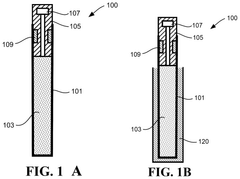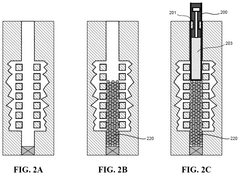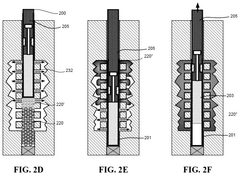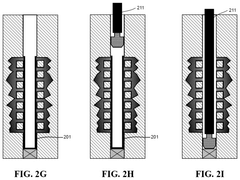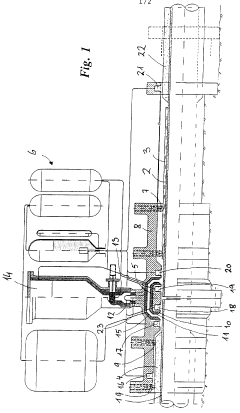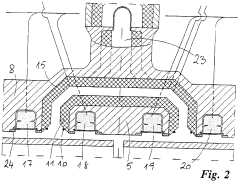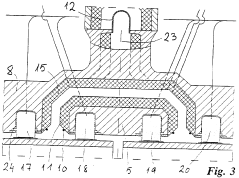Thermite: A Key Component in Underwater Welding Solutions
JUN 24, 20259 MIN READ
Generate Your Research Report Instantly with AI Agent
Patsnap Eureka helps you evaluate technical feasibility & market potential.
Thermite Welding Evolution
Thermite welding has undergone significant evolution since its inception in the late 19th century. Initially developed for railway track welding, this exothermic process has found its way into various industries, including underwater applications. The evolution of thermite welding in underwater environments has been driven by the need for reliable and efficient joining techniques in challenging marine conditions.
In the early stages of underwater thermite welding, the primary challenge was to create a dry environment for the reaction to occur. This led to the development of specialized enclosures and cofferdams to isolate the welding area from water. As technology progressed, more sophisticated methods emerged, such as the use of water-resistant thermite mixtures and improved ignition systems.
The 1970s and 1980s saw a surge in offshore oil and gas exploration, which spurred further advancements in underwater thermite welding. During this period, researchers focused on enhancing the reliability and strength of thermite welds in deep-sea environments. This led to the development of new thermite compositions tailored specifically for underwater use, incorporating additives to improve weld quality and reduce porosity.
In the 1990s and early 2000s, automation began to play a crucial role in underwater thermite welding. Remote-operated vehicles (ROVs) equipped with thermite welding capabilities were introduced, allowing for more precise and controlled welding operations at greater depths. This technological leap significantly improved safety and efficiency in underwater repair and construction projects.
Recent years have seen a focus on improving the environmental impact of thermite welding. Researchers have been developing eco-friendly thermite mixtures that produce fewer harmful byproducts and reduce the overall carbon footprint of underwater welding operations. Additionally, advancements in computer modeling and simulation have allowed for better prediction and optimization of thermite reactions under various underwater conditions.
The integration of smart technologies and IoT (Internet of Things) has been a recent trend in thermite welding evolution. Sensors and real-time monitoring systems are now being incorporated into underwater thermite welding setups, providing valuable data on weld quality, temperature profiles, and reaction kinetics. This data-driven approach has led to more consistent and reliable welds, even in the most challenging underwater environments.
Looking ahead, the evolution of thermite welding in underwater applications is likely to continue focusing on increased automation, improved environmental sustainability, and enhanced precision. Emerging technologies such as AI-driven welding systems and advanced materials science are expected to play significant roles in shaping the future of underwater thermite welding, further expanding its capabilities and applications in marine engineering and offshore industries.
In the early stages of underwater thermite welding, the primary challenge was to create a dry environment for the reaction to occur. This led to the development of specialized enclosures and cofferdams to isolate the welding area from water. As technology progressed, more sophisticated methods emerged, such as the use of water-resistant thermite mixtures and improved ignition systems.
The 1970s and 1980s saw a surge in offshore oil and gas exploration, which spurred further advancements in underwater thermite welding. During this period, researchers focused on enhancing the reliability and strength of thermite welds in deep-sea environments. This led to the development of new thermite compositions tailored specifically for underwater use, incorporating additives to improve weld quality and reduce porosity.
In the 1990s and early 2000s, automation began to play a crucial role in underwater thermite welding. Remote-operated vehicles (ROVs) equipped with thermite welding capabilities were introduced, allowing for more precise and controlled welding operations at greater depths. This technological leap significantly improved safety and efficiency in underwater repair and construction projects.
Recent years have seen a focus on improving the environmental impact of thermite welding. Researchers have been developing eco-friendly thermite mixtures that produce fewer harmful byproducts and reduce the overall carbon footprint of underwater welding operations. Additionally, advancements in computer modeling and simulation have allowed for better prediction and optimization of thermite reactions under various underwater conditions.
The integration of smart technologies and IoT (Internet of Things) has been a recent trend in thermite welding evolution. Sensors and real-time monitoring systems are now being incorporated into underwater thermite welding setups, providing valuable data on weld quality, temperature profiles, and reaction kinetics. This data-driven approach has led to more consistent and reliable welds, even in the most challenging underwater environments.
Looking ahead, the evolution of thermite welding in underwater applications is likely to continue focusing on increased automation, improved environmental sustainability, and enhanced precision. Emerging technologies such as AI-driven welding systems and advanced materials science are expected to play significant roles in shaping the future of underwater thermite welding, further expanding its capabilities and applications in marine engineering and offshore industries.
Underwater Welding Demand
The demand for underwater welding solutions has been steadily increasing in recent years, driven by the growing offshore oil and gas industry, marine infrastructure development, and underwater construction projects. As global energy demands continue to rise, offshore exploration and production activities have expanded, necessitating reliable underwater welding techniques for pipeline installation, repair, and maintenance.
The offshore wind energy sector has also contributed significantly to the demand for underwater welding. As more countries invest in renewable energy sources, the installation and maintenance of offshore wind turbines require specialized underwater welding capabilities. This trend is particularly evident in regions such as Europe, where offshore wind farms are becoming increasingly prevalent.
In addition to energy-related applications, underwater welding is crucial for marine infrastructure projects, including the construction and repair of ports, harbors, and offshore platforms. The expansion of global trade and the need for modernizing existing maritime facilities have further fueled the demand for advanced underwater welding solutions.
The shipbuilding and repair industry represents another significant market for underwater welding. As the global shipping fleet continues to grow and age, there is an increasing need for underwater repair and maintenance services. This demand is particularly strong in major shipping hubs and coastal regions with high maritime traffic.
Environmental concerns and stricter regulations have also influenced the underwater welding market. The need for eco-friendly and efficient welding techniques that minimize environmental impact has led to increased research and development efforts in this field. This has created opportunities for innovative solutions that can meet both technical and environmental requirements.
The defense sector is another key driver of underwater welding demand. Naval vessels and submarines require regular maintenance and repair, often necessitating underwater welding operations. As nations continue to invest in their naval capabilities, the demand for specialized underwater welding services in the defense sector is expected to remain strong.
Despite the growing demand, the underwater welding industry faces several challenges. These include the need for highly skilled personnel, the development of more efficient and safer welding techniques, and the adaptation to increasingly complex underwater environments. As a result, there is a continuous push for technological advancements and innovation in underwater welding solutions, creating opportunities for new market entrants and established players alike.
The offshore wind energy sector has also contributed significantly to the demand for underwater welding. As more countries invest in renewable energy sources, the installation and maintenance of offshore wind turbines require specialized underwater welding capabilities. This trend is particularly evident in regions such as Europe, where offshore wind farms are becoming increasingly prevalent.
In addition to energy-related applications, underwater welding is crucial for marine infrastructure projects, including the construction and repair of ports, harbors, and offshore platforms. The expansion of global trade and the need for modernizing existing maritime facilities have further fueled the demand for advanced underwater welding solutions.
The shipbuilding and repair industry represents another significant market for underwater welding. As the global shipping fleet continues to grow and age, there is an increasing need for underwater repair and maintenance services. This demand is particularly strong in major shipping hubs and coastal regions with high maritime traffic.
Environmental concerns and stricter regulations have also influenced the underwater welding market. The need for eco-friendly and efficient welding techniques that minimize environmental impact has led to increased research and development efforts in this field. This has created opportunities for innovative solutions that can meet both technical and environmental requirements.
The defense sector is another key driver of underwater welding demand. Naval vessels and submarines require regular maintenance and repair, often necessitating underwater welding operations. As nations continue to invest in their naval capabilities, the demand for specialized underwater welding services in the defense sector is expected to remain strong.
Despite the growing demand, the underwater welding industry faces several challenges. These include the need for highly skilled personnel, the development of more efficient and safer welding techniques, and the adaptation to increasingly complex underwater environments. As a result, there is a continuous push for technological advancements and innovation in underwater welding solutions, creating opportunities for new market entrants and established players alike.
Thermite Challenges
Despite the numerous advantages of thermite in underwater welding, several significant challenges persist in its application. One of the primary concerns is the control of the exothermic reaction in an aqueous environment. The intense heat generated by thermite can lead to rapid cooling and potential cracking of the weld, compromising its structural integrity. This issue is exacerbated by the high thermal conductivity of water, which quickly dissipates heat from the welding area.
Another challenge lies in the ignition of thermite underwater. Traditional ignition methods often prove ineffective in submerged conditions, necessitating the development of specialized underwater ignition systems. These systems must be capable of generating sufficient heat to initiate the thermite reaction while remaining operational in high-pressure aquatic environments.
The containment of the thermite reaction presents another significant hurdle. In terrestrial applications, the reaction can be easily confined, but underwater, the explosive nature of the reaction coupled with water pressure can lead to dispersion of the molten metal, reducing weld quality and potentially posing safety risks to divers and equipment.
Precision in thermite placement and dosage is crucial yet challenging in underwater conditions. Currents, poor visibility, and the physical constraints of working in a submerged environment make it difficult to accurately position and measure the thermite mixture. This can result in inconsistent weld quality and wasted materials.
The environmental impact of thermite use in underwater welding is also a growing concern. The release of reaction byproducts and potential contamination of the marine ecosystem necessitate careful consideration and mitigation strategies. Developing eco-friendly thermite compositions that maintain effectiveness while minimizing environmental harm remains an ongoing challenge.
Lastly, the safety of underwater welders working with thermite poses significant challenges. The combination of high temperatures, potential for explosive reactions, and the inherent risks of underwater work environments requires robust safety protocols and specialized equipment. Balancing these safety requirements with operational efficiency and weld quality is a complex task that continues to challenge the industry.
Another challenge lies in the ignition of thermite underwater. Traditional ignition methods often prove ineffective in submerged conditions, necessitating the development of specialized underwater ignition systems. These systems must be capable of generating sufficient heat to initiate the thermite reaction while remaining operational in high-pressure aquatic environments.
The containment of the thermite reaction presents another significant hurdle. In terrestrial applications, the reaction can be easily confined, but underwater, the explosive nature of the reaction coupled with water pressure can lead to dispersion of the molten metal, reducing weld quality and potentially posing safety risks to divers and equipment.
Precision in thermite placement and dosage is crucial yet challenging in underwater conditions. Currents, poor visibility, and the physical constraints of working in a submerged environment make it difficult to accurately position and measure the thermite mixture. This can result in inconsistent weld quality and wasted materials.
The environmental impact of thermite use in underwater welding is also a growing concern. The release of reaction byproducts and potential contamination of the marine ecosystem necessitate careful consideration and mitigation strategies. Developing eco-friendly thermite compositions that maintain effectiveness while minimizing environmental harm remains an ongoing challenge.
Lastly, the safety of underwater welders working with thermite poses significant challenges. The combination of high temperatures, potential for explosive reactions, and the inherent risks of underwater work environments requires robust safety protocols and specialized equipment. Balancing these safety requirements with operational efficiency and weld quality is a complex task that continues to challenge the industry.
Current Thermite Solutions
01 Thermite composition and ignition methods
Thermite compositions typically consist of metal oxides and aluminum powder. Various ignition methods are used, including electrical, chemical, and mechanical means. The reaction produces intense heat and molten metal, making it useful for welding, incendiary devices, and metal purification.- Thermite composition and applications: Thermite is a pyrotechnic composition of metal powder fuel and metal oxide. It's used in various applications including welding, incendiary devices, and metal purification. The reaction produces intense heat and molten metal, making it suitable for specialized industrial and military uses.
- Thermite in downhole tools and well operations: Thermite reactions are utilized in downhole tools for oil and gas wells. These tools employ thermite to generate heat for various purposes such as sealing wellbores, cutting tubulars, or initiating other downhole processes. The controlled use of thermite in these applications provides efficient and reliable performance in challenging environments.
- Thermite in additive manufacturing and 3D printing: Thermite materials are being explored in additive manufacturing processes. This includes the development of thermite-based feedstocks for 3D printing and the creation of structures with embedded thermite components. These innovations open up new possibilities for producing complex parts with integrated energetic materials.
- Thermite in armor systems and protective structures: Thermite reactions are incorporated into advanced armor systems and protective structures. These applications utilize the heat-generating properties of thermite to enhance protection against ballistic threats or to create self-sealing capabilities in damaged structures. The controlled use of thermite in these systems provides improved survivability and damage mitigation.
- Thermite reaction control and initiation methods: Various methods and devices have been developed to control and initiate thermite reactions. These include specialized ignition systems, reaction rate modifiers, and containment designs. The focus is on achieving precise control over the thermite reaction to enhance safety, efficiency, and applicability in different scenarios.
02 Applications in oil and gas well operations
Thermite reactions are utilized in oil and gas well operations for tasks such as cutting pipes, sealing wells, and initiating other downhole tools. The high temperature generated by the reaction can effectively melt through metal barriers and create seals in harsh environments.Expand Specific Solutions03 Use in additive manufacturing and 3D printing
Thermite reactions are being explored in additive manufacturing processes. The heat generated can be used to fuse metal powders or create unique material properties. This application shows potential in producing complex metal parts or structures with specific characteristics.Expand Specific Solutions04 Safety and control mechanisms
Given the intense nature of thermite reactions, various safety and control mechanisms have been developed. These include specialized containment vessels, controlled ignition systems, and methods to modulate the reaction rate. Such measures are crucial for safe handling and application of thermite in various industries.Expand Specific Solutions05 Environmental and waste management applications
Thermite reactions are being investigated for environmental remediation and waste management. The high temperatures generated can be used to destroy hazardous materials or treat contaminated soils. This application shows promise in addressing certain environmental challenges.Expand Specific Solutions
Key Industry Players
The underwater welding industry, utilizing thermite technology, is in a growth phase with increasing market size due to expanding offshore and marine infrastructure projects. The global underwater welding market is projected to reach significant value in the coming years, driven by oil and gas exploration and underwater construction activities. Technologically, the field is advancing rapidly, with companies like BiSN Oil Tools Ltd. and Isol8 (holdings) Ltd leading innovations in thermite-based solutions. Major players such as ConocoPhillips Co. and ExxonMobil Technology & Engineering Co. are investing in research and development to enhance the efficiency and safety of underwater welding techniques. Academic institutions like the University of Houston and South China University of Technology are contributing to the technological maturity through collaborative research efforts with industry partners.
ConocoPhillips Co.
Technical Solution: ConocoPhillips has developed a thermite-based underwater repair system for offshore oil and gas pipelines. Their approach uses a remotely operated vehicle (ROV) to deliver and position a thermite-filled repair sleeve around damaged sections of underwater pipelines. The thermite reaction is initiated remotely, melting and fusing the repair sleeve to the pipeline. The company has also developed a specialized cooling system that rapidly dissipates heat after the reaction, preventing thermal damage to the surrounding pipeline coating and marine environment.
Strengths: Tailored for offshore oil and gas industry, ROV-assisted application for deep-water use. Weaknesses: Potentially limited to specific pipeline materials and sizes, may require significant setup time.
Petróleo Brasileiro SA
Technical Solution: Petrobras has developed an innovative thermite-based underwater welding solution for repairing subsea equipment and structures. Their system uses a specially designed thermite cartridge that can be activated underwater. The cartridge is enclosed in a pressure-resistant chamber that maintains a dry environment for the reaction. Petrobras has also developed a proprietary thermite mixture that produces a more fluid slag, allowing for better flow and coverage in underwater conditions. The company's method includes a post-weld heat treatment system that uses the residual heat from the thermite reaction to improve the mechanical properties of the weld.
Strengths: Designed for deep-water applications, innovative pressure-resistant reaction chamber, improved slag fluidity. Weaknesses: May be limited to specific types of subsea equipment and structures, potentially high cost per application.
Thermite Innovations
Tool for metal plugging or sealing of casing
PatentActiveUS12129735B2
Innovation
- A plugging device with a cylindrical sleeve containing thermite that is ignitable by an ignition mechanism, allowing for the melting of meltable plugging material to flow laterally into perforations, and the tool's retrievable design for reconditioning and reuse.
Method and device for thermite welding at large water depths
PatentWO1997037806A1
Innovation
- A compact thermite welding device and method that allows for remote-controlled welding of pipe joints using a sealing ring and refractory linings, enabling adjustment of pipe ends with increased tolerances and accommodating angles, utilizing a remote-operated vehicle and nitrogen protection gas.
Safety Regulations
The use of thermite in underwater welding operations necessitates stringent safety regulations due to its highly reactive nature and the inherent risks associated with underwater work environments. Regulatory bodies such as the Occupational Safety and Health Administration (OSHA) and the International Maritime Organization (IMO) have established comprehensive guidelines to ensure the safe handling and application of thermite in underwater welding processes.
These regulations typically cover several key areas, including personnel qualifications, equipment standards, and operational procedures. Welders and support staff involved in thermite-based underwater welding must undergo specialized training and certification programs that focus on the unique challenges of working with thermite in submerged conditions. This training encompasses proper handling techniques, emergency response protocols, and the use of personal protective equipment (PPE) specifically designed for underwater thermite welding.
Equipment used in thermite underwater welding operations must meet rigorous safety standards. This includes the use of corrosion-resistant materials, fail-safe ignition systems, and robust containment mechanisms to prevent unintended reactions or dispersal of thermite materials. Additionally, regulations often mandate the use of remote monitoring systems and real-time communication devices to ensure constant supervision and rapid response capabilities in case of emergencies.
Operational procedures for thermite underwater welding are subject to strict protocols. These include mandatory pre-operation safety briefings, establishment of exclusion zones around the welding site, and implementation of multi-layered safety checks throughout the welding process. Regulations also dictate specific environmental considerations, such as water current assessments and visibility requirements, to minimize risks associated with the underwater environment.
Storage and transportation of thermite materials for underwater welding are governed by specific regulations to prevent accidental ignition or exposure. These rules typically require specialized containment units, clear labeling, and detailed documentation of thermite quantities and movements. Furthermore, disposal of unused thermite and by-products must adhere to environmental protection standards to prevent contamination of marine ecosystems.
Regular safety audits and inspections are mandated to ensure ongoing compliance with these regulations. These assessments often involve third-party verification and documentation to maintain transparency and accountability in thermite-based underwater welding operations. Continuous improvement of safety measures is encouraged through periodic review and update of regulations based on new research, technological advancements, and lessons learned from industry experiences.
These regulations typically cover several key areas, including personnel qualifications, equipment standards, and operational procedures. Welders and support staff involved in thermite-based underwater welding must undergo specialized training and certification programs that focus on the unique challenges of working with thermite in submerged conditions. This training encompasses proper handling techniques, emergency response protocols, and the use of personal protective equipment (PPE) specifically designed for underwater thermite welding.
Equipment used in thermite underwater welding operations must meet rigorous safety standards. This includes the use of corrosion-resistant materials, fail-safe ignition systems, and robust containment mechanisms to prevent unintended reactions or dispersal of thermite materials. Additionally, regulations often mandate the use of remote monitoring systems and real-time communication devices to ensure constant supervision and rapid response capabilities in case of emergencies.
Operational procedures for thermite underwater welding are subject to strict protocols. These include mandatory pre-operation safety briefings, establishment of exclusion zones around the welding site, and implementation of multi-layered safety checks throughout the welding process. Regulations also dictate specific environmental considerations, such as water current assessments and visibility requirements, to minimize risks associated with the underwater environment.
Storage and transportation of thermite materials for underwater welding are governed by specific regulations to prevent accidental ignition or exposure. These rules typically require specialized containment units, clear labeling, and detailed documentation of thermite quantities and movements. Furthermore, disposal of unused thermite and by-products must adhere to environmental protection standards to prevent contamination of marine ecosystems.
Regular safety audits and inspections are mandated to ensure ongoing compliance with these regulations. These assessments often involve third-party verification and documentation to maintain transparency and accountability in thermite-based underwater welding operations. Continuous improvement of safety measures is encouraged through periodic review and update of regulations based on new research, technological advancements, and lessons learned from industry experiences.
Environmental Impact
The use of thermite in underwater welding solutions presents significant environmental considerations that must be carefully evaluated and addressed. The high-temperature exothermic reaction of thermite, while effective for joining metals underwater, can potentially impact marine ecosystems in several ways.
Firstly, the intense heat generated during the thermite reaction can cause localized thermal pollution in the immediate vicinity of the welding site. This sudden temperature increase may disrupt the delicate balance of marine life, affecting both flora and fauna in the surrounding area. Sensitive organisms, particularly those with limited mobility, may suffer from thermal stress or even mortality if exposed to these extreme conditions.
Additionally, the byproducts of the thermite reaction, including metal oxides and slag, can introduce foreign materials into the aquatic environment. These substances may settle on the seabed or remain suspended in the water column, potentially altering the chemical composition of the local ecosystem. The long-term effects of these materials on marine life, including potential bioaccumulation in the food chain, require thorough investigation and monitoring.
The release of gases during the thermite reaction is another environmental concern. While the underwater environment may mitigate some of the gaseous emissions, certain compounds could still dissolve in the water or escape to the surface, potentially contributing to water pollution or atmospheric emissions. The extent of this impact depends on factors such as the depth of the welding operation and the specific composition of the thermite mixture used.
Furthermore, the use of thermite in underwater welding may indirectly affect marine habitats through the installation and removal of temporary structures required for the welding process. These activities can cause physical disturbances to the seabed, potentially damaging benthic communities or sensitive marine habitats such as coral reefs or seagrass beds.
To mitigate these environmental impacts, it is crucial to develop and implement strict protocols for the use of thermite in underwater welding. This includes careful selection of welding sites to minimize ecological disruption, use of containment systems to capture and properly dispose of reaction byproducts, and the development of more environmentally friendly thermite compositions. Additionally, comprehensive environmental impact assessments should be conducted before undertaking large-scale underwater welding projects involving thermite.
Ongoing research into alternative underwater welding technologies that offer similar effectiveness with reduced environmental impact is also essential. This may include the exploration of lower-temperature exothermic reactions or the development of novel welding techniques specifically designed for underwater applications that minimize ecological disturbances.
Firstly, the intense heat generated during the thermite reaction can cause localized thermal pollution in the immediate vicinity of the welding site. This sudden temperature increase may disrupt the delicate balance of marine life, affecting both flora and fauna in the surrounding area. Sensitive organisms, particularly those with limited mobility, may suffer from thermal stress or even mortality if exposed to these extreme conditions.
Additionally, the byproducts of the thermite reaction, including metal oxides and slag, can introduce foreign materials into the aquatic environment. These substances may settle on the seabed or remain suspended in the water column, potentially altering the chemical composition of the local ecosystem. The long-term effects of these materials on marine life, including potential bioaccumulation in the food chain, require thorough investigation and monitoring.
The release of gases during the thermite reaction is another environmental concern. While the underwater environment may mitigate some of the gaseous emissions, certain compounds could still dissolve in the water or escape to the surface, potentially contributing to water pollution or atmospheric emissions. The extent of this impact depends on factors such as the depth of the welding operation and the specific composition of the thermite mixture used.
Furthermore, the use of thermite in underwater welding may indirectly affect marine habitats through the installation and removal of temporary structures required for the welding process. These activities can cause physical disturbances to the seabed, potentially damaging benthic communities or sensitive marine habitats such as coral reefs or seagrass beds.
To mitigate these environmental impacts, it is crucial to develop and implement strict protocols for the use of thermite in underwater welding. This includes careful selection of welding sites to minimize ecological disruption, use of containment systems to capture and properly dispose of reaction byproducts, and the development of more environmentally friendly thermite compositions. Additionally, comprehensive environmental impact assessments should be conducted before undertaking large-scale underwater welding projects involving thermite.
Ongoing research into alternative underwater welding technologies that offer similar effectiveness with reduced environmental impact is also essential. This may include the exploration of lower-temperature exothermic reactions or the development of novel welding techniques specifically designed for underwater applications that minimize ecological disturbances.
Unlock deeper insights with Patsnap Eureka Quick Research — get a full tech report to explore trends and direct your research. Try now!
Generate Your Research Report Instantly with AI Agent
Supercharge your innovation with Patsnap Eureka AI Agent Platform!
